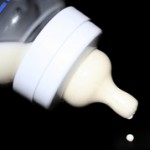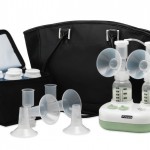
One concern many breastfeeding moms have is to know how much breast milk to put in a bottle for their baby.
I remember making bottles for the first time when I was preparing to go back to work after my maternity leave ended with my first baby.
Because I had only given my son a bottle a hand full of times, I had no idea how much to leave him for each feeding or that there was a way to feed him to keep him from taking in more than he wanted or needed.
It became a trial and error process but unfortunately for me, a lot of precious breast milk went to waste at the time.
So how much breast milk does baby need? And what is the best way to feed your baby a bottle?

How Much Breast Milk Does Baby Need & Paced Feeding
How Much Breast Milk to Feed Your Baby
It may surprise you to know that breastfed babies take in less milk per bottle than formula fed babies. This is because breast milk is much better utilized by the body with very little waste, so less is needed.
The average breastfed baby takes in 25 oz in a 24 hour period during 1-6 months of age.
You will get a feel for how much to give per bottle fairly quickly but here are some helpful suggestions:
Birth – 2 Months: 2-5 oz per feeding
2 Months – 4 Months: 4-6 oz per feeding
4 Months – 6 Months: 5-7 oz per feeding
Another way to calculate how many ounces is by weight.
Typically a baby needs 2.5 ounces per pound daily. So a 10-pound baby would need 25 ounces in a 24 hour period of time. If he eats 8 times a day, then each bottle would need to be just over 3 ounces, so round up to 3.5 ounces.
Bottle Feeding a Breastfed Baby
For young babies, it is best to select a bottle with a slow flow nipple. Most bottle brands give the option for you to purchase different flow nipples (newborn, 3+ months, 6+ months, etc).
It is important to remember that it is possible to overfeed a baby using a bottle. The reason is that the baby cannot control the flow of the milk like they can with the breast.
They will continue swallowing which can lead to frequent spitting up.

Another important fact about feeding a baby breast milk is that it is digested in about 90 minutes. You should feed your baby on demand and just like a nursing baby would be fed. You should expect the be feeding your baby every 1.5-3 hours.
Baby may take 20 or more minutes to finish a bottle. Gently burping baby midway through or at the end of the feed is recommended. Remember it is not a good idea to prop a bottle up to feed your baby.
Paced Feeding Method
Why You Should Consider Paced Feeding for Your Baby
Paced feeding refers to a method the help your baby eat more slowly during a feeding which mimics how they would eat directly from the breast.
The idea behind paced feeding is taking natural breaks during the process of bottle feeding. When a baby breastfeeds, they need to suckle for a time, then the mother’s milk lets down and starts to flow, then it eases up again, and then lets down, etc. Paced feeding mimics this process and can make switching from breast to bottle and back much easier.
One issue moms run into when bottle feeding is what many refer to as “nipple confusion.” The real issue is that letting a baby suck down a bottle in a matter of minutes can actually cause them to start to prefer the fast pace. Being on the breast starts to become frustrating for them as the milk flow takes natural breaks.
Now, once a baby is older and has mastered bottle feeding, they can control the pace themselves and will not need your help in doing so.
Some signs that your baby cannot control the flow include gulping, gasping/catch-up breaths, wide-eyes, frowning or furrowed brow, milk leaking from sides of the mouth, or finishing the bottle very, very quickly.
How to Use the Paced Feeding Method
Paced feeding does take some practice. So being patient and following your baby’s lead is a must.
Here is how to use the paced feeding method:
- Hold baby upright at, at least a 45-degree angle.
- Gently stroke baby’s upper lip with the bottle nipple.
- Let baby reach up and naturally latch the bottle nipple.
- Hold the bottle level (not tilted all the way) and let the baby suck a few times before slowly allowing the milk to flow into the nipple.
- Let baby feed 20 to 30 seconds and slowly tilt the bottle down without taking the nipple out of baby’s mouth.
- Allow baby to rest and once they start sucking again, tilt the bottle back to level and slowly allow the milk to fill the nipple again.
- Repeat.
A feeding is over when the baby indicates they have had enough by either unlatching, not continuing to suck, turning their head, etc.
It is tempting to try and get to finish a bottle especially if there is just a tiny bit left but try and resist that urge. When a baby breastfeeds, they end the feeding when full and it is important to follow those cues.
This article has some additional info on feeding your breastfed baby a bottle and paced feeding.
See the Paced Feeding Method in Action
This video walks you through how to pace feed and what it should look like.
One thing I was feeling uneasy about was that it appears the baby is taking in a lot of air and it seems we are always taught to not let that happen. The more I have read about paced feeding and air intake, the less concerned I was about it. A good burp seems to be all that’s needed.
So burp your baby often when using this method!
Best Bottles for a Breastfed Baby
Choosing a bottle for your breastfed baby isn’t easy.
Many moms will report that they had to try a number of bottles before settling on a brand their baby would accept.
When comparing bottles keeping a few things in mind can help:
- Making sure your baby has a nipple that they can “latch” on to with their lips flared like they do when breastfeeding is important. A wide mouth bottle is probably a better idea.
- Flow is a huge concern as I explained above, so finding a bottle that helps your baby control the flow of the milk is a must. Go with the slowest nipple you can find.
Not all bottles are created equal. So what are some of the best for a breastfed baby?
Here is a list of 3 of my favorites!
1 – Comotomo Baby Bottle
The Comotomo Baby Bottles are designed with a naturally shaped nipple that mimics the breast. It is made of soft, skin-like silicone that makes it easy for baby to grip. It doesn’t leak and has dual vents to help reduce the air ingested by baby. This is a great choice for a breastfed baby!
Read more about the Comotomo baby and see where to buy them, here!
2 – Mimijumi
I had the pleasure of seeing the Mimijumi bottles at last year’s ABC Kids Expo. I was blown away by the design of this bottle.
It is designed with the widest mouth on the market, has very few pieces so is easy to clean and assemble. Its innovative design stimulated oral and dental development just like breastfeeding. But more importantly, it allows your baby to control the flow of milk making it easier to switch from breast to bottle.
The nipple is a natural shape and has a venting system that reduces colic. It is also made of food grade silicone and nylon and feels like skin.
The Mimijumi is one of the most natural feeling and breast-like bottles I have tested. Perfect for a breastfed baby!
Read more about the Mimijumi Bottle and see where to buy them, here!
3 – Tommee Tippee Closer to Nature
The Tommee Tippee Closer to Nature line is award-winning. Their wide neck bottles are designed to mimic the natural flex, stretch, and movement of mom’s breast. It features an easy vent value to help reduce air. They are BPA free.
Tommee Tippee is a favorite among moms and a go-to bottle if you are having trouble finding a bottle your baby will take.
Read more about the Tommee Tippee Closer to Nature and where to buy them, here!
Figuring out the logistics of bottle feeding your breastfed baby can be some trial and error but it is important to follow your baby’s lead.
Practicing paced feeding with a slow flow, a breast-like bottle can help.
Have questions or comments about bottle feeding your breastfed baby? Drop them below! I would love to hear from you!
Next up:
How to Build a Freezer Stash of Breast Milk – READ NOW—->
Need a Sample Pumping Schedule? Try This One! – READ NOW—->
Also See –

Read: Concerned You are Not Pumping Enough Breast Milk? Find Out How to Tell and What You Can do About it.
Pin It For Later!





